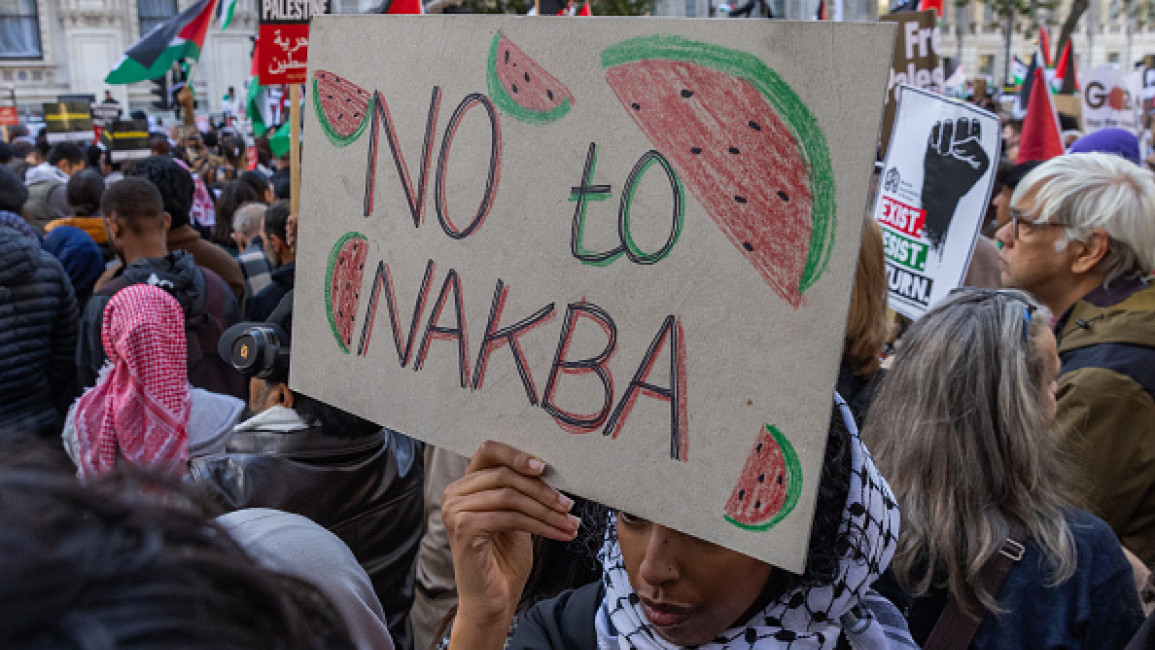Watermelon emojis and Gaza: Why is the fruit a symbol of Palestinian solidarity?
The watermelon, a summer fruit famously grown in the West Bank and the Gaza Strip, has become an unofficial symbol of Palestine solidarity – particularly amid Israel's brutal war on Gaza.
When cut open, the fruit bears the same colours as the Palestinian national flag red, green, black and white. During global protests spanning all corners of the globe, the watermelon has been drawn on posters, painted on faces and displayed in balloon form, with protesters even handing out chunks to fellow demonstrators and passers-by.
The fruit has also appeared significantly in emoji form under social media posts and has been placed next to user or display names to show support for the people of Palestine.
Many have adopted the watermelon emoji to evade online censorship, which has become common on Meta-owned Facebook and Instagram – which have both restricted pro-Palestinian content over the years.
A watermelon filter created to raise money for those suffering in Gaza has gone viral on TikTok and has fast become one of the most popular filters on the video-sharing app.
How did the watermelon Palestine symbolism emerge?
The Palestinian flag and anything relating to it has long-faced repression by Israel.
The national flag, a tricolour of white, green and black with a red triangle placed at the hoist, was banned by Israel during the Six-Day War of 1967 after which Israel annexed East Jerusalem and the whole of the West Bank and Gaza. In 1980, a military order was placed prohibiting the display of any visual media alluding to it.
It wasn’t until 1993, at the signing of the Oslo Accords, that the ban was lifted, but that didn't stop Israeli forces from confiscating the flags.
In 1980, three artists - Sliman Mansour, Nabil Anani and Issam Badr - were famously arrested at a gallery in Ramallah, in the West Bank, for displaying art allegedly related to the flag.
Badr, following his arrest, responded: "Well, if I paint a flower with these colours, what will you do?". The officer replied: "It would be confiscated. Even if you do a watermelon, it will be confiscated."
Mansour confirmed that the incident occurred in an interview with UAE newspaper The National in 2021.
"The watermelon was mentioned, but by the Israeli officer," he said after describing the confrontation between Badr and Israeli police.
Mansour, now in his seventies, first painted watermelons in a 1987 book on Palestinian folk stories and said that the fruit’s use among artists was not prevalent during that period.
It is possible to say that the watermelon became a Palestinian symbol from this moment.
The watermelon, INTIFADA'S and GAZA
The symbolism of the watermelon certainly spurred on renowned artist Khaled Hourani to paint the watermelon flag to commemorate the legacy of resistance and the prohibition of the Palestinian flag.
Hourani created his now-famed design after the Second Intifada in 2007 for the Subjective Atlas of Palestine initiative, which he then waved at many exhibitions worldwide.
"Art is part of the conflict. It’s about culture, it’s about representation," Hourani told The New York Times (NYT) in 2023, amid Israel's military campaign in Gaza, which has now killed 21,320 Palestinians, many of whom are women and children.
Hourani’s works have gone on to inspire other Palestinian artists, such as Beesan Arafat and Sarah Hatahet, to incorporate the fruit into their works.
A 1993 NYT report suggested that Palestinians in the Gaza Strip were arrested for carrying pieces of watermelon, as it has the same colours as the Palestinian flag. The report, however, was retracted as NYT could not confirm the incident.
Fast forward to 2021, when Israeli forces were forcibly expelling families from east Jerusalem's Sheikh Jarrah neighbourhood. Watermelon symbolism saw a resurgence during protests and demonstrations, which also coincided with Israel's deadly military campaign in Gaza in that same year.
The origins of the watermelon as an alternative to the Palestinian flag may be uncertain. Still, it has cemented its status as a bold signifier of Palestinian identity, resistance and solidarity amid Israel's attacks on Palestine and its people.



